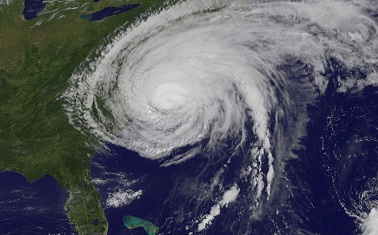Study: Climate change may push hurricanes farther north, south

The hurricane season of 2014 just kicked off, and with two devastating storms wreaking havoc along the northeastern United States coast over the last few years, it’s no wonder everyone’s on edge.
We’re concerned about hurricanes becoming more frequent and intense, and about the worsening storm surge caused by a rise in sea levels. But flying under the radar is a fourth link between hurricanes and climate change: how climate change affects the location of hurricanes.
A new study led by researchers at the National Oceanic and Atmospheric Administration, the Massachusetts Institute of Technology and Princeton University found that hurricanes have been shifting pole-ward at a rate of 30 to 40 miles per decade over the last 30 years.
It means they are moving closer to major population centers such as Washington, New York and Boston.
The likely cause? Human-caused climate change.
The migration of hurricanes has “potentially profound consequences for life and property,” the authors of the study warn in an article published recently in the journal Nature.
“Increasing hazard exposure and mortality risk from tropical cyclones may be compounded in coastal cities outside the tropics, while being offset at lower latitudes.”
Linking climate change to hurricane location
This finding is an important advancement in scientists’ understanding of how climate change has already contributed to extreme weather events. Research shows that the rise in global temperatures already causes more warm days, heat waves, and heavy rainfall.
Detecting trends in hurricane activity has been difficult, however, due to inconsistent and often unreliable historical data.
To get around this data challenge, the scientists at NOAA, MIT and Princeton developed a new technique that relies on a dependable subset of the data, and which teases out natural events such as El Niño to detect a distinct relationship between hurricane activity and climate change.
Their conclusion: Hurricanes are drifting toward the poles most likely due to an expansion of the Hadley Cell, a permanent atmospheric circulation feature that carries heat from the tropics to the Earth’s temperate zones.
Scientific understanding is that the Hadley Cell expansion is a result of the increase in heat-trapping gases in the atmosphere from human activities. So as we continue to drive cars, generate electricity at fossil-fueled power plants, cut down trees, and farm – we are indirectly pushing hurricanes farther north and south.
The new study is groundbreaking not only because it uses a novel technique, but also because it links a hurricane trend to climate change.
What we know so far
So where are we today with hurricanes and climate change?
Scientists studying hurricanes:
- Have found no observed trend in frequency
- Have not been able to detect trends in intensity and duration
- Are confident that human-caused sea level rise is contributing to storm surge
- Expect the frequency of intense storms to increase in the future
- Have now detected a robust trend in location shifts that is likely due to human activity
This new research presented in Nature suggests that hurricanes are migrating toward the poles and may devastate densely populated coastal regions that had previously, for the most part, been spared such storms.
It’s yet another reason why we must act now to curb carbon pollution and limit climate change.
This post first appeared on EDF Voices













One Comment
He also led the Warhawks iin rushing with 441 yards and 7 touchdowns.
In those 7 games the Air Force Falconms went
3-4 with wins over BYU, Army, and Navy. Perhaps you can relate
to that and sense misplaced simmply because nothing you had been trained is functioning.
Have a look at my homepage :: 24 day challenge